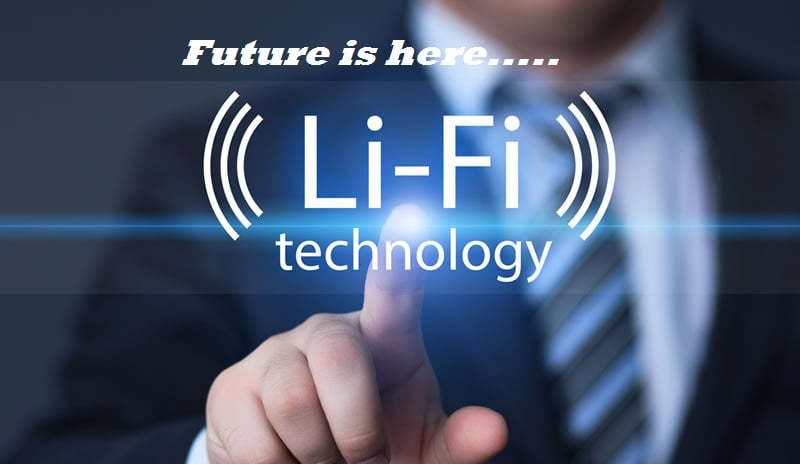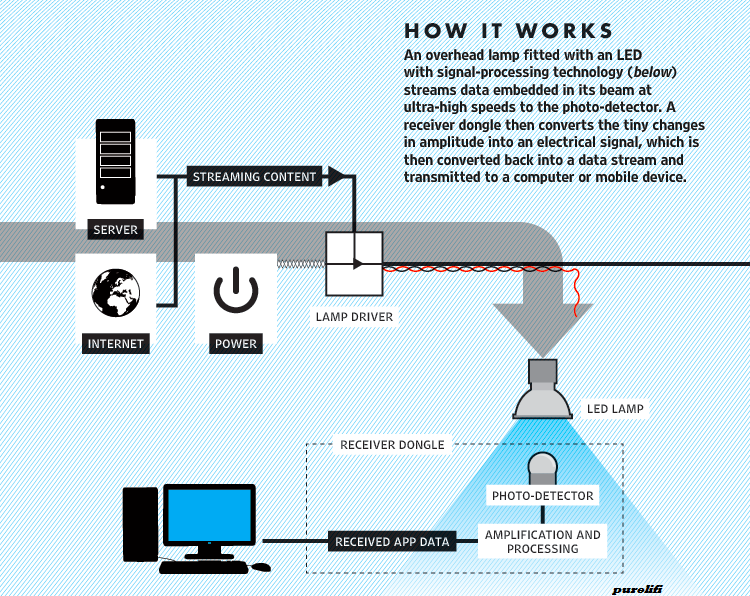“Li-Fi, wireless technology promising 100 times faster internet access than Wi-Fi”, “Lightning fast alternative to Wi-Fi”, “Li-Fi, internet by light promises to leave Wi-Fi eating dust”, these are the phrases that are commonly going around about the new wireless technology Li-Fi. It indicates that it is some fast, very fast technology that is going to revolutionize the speed of internet access. So let’s check out what Li-Fi is and how it works.
What is Li-Fi?
The inventor of Li-Fi, Professor Harald Hass, Co-founder of pureLiFi and Chair of Mobile Communications at UK’s University of Edinburgh, refers Li-Fi as light based communications technology. It is a high speed, bidirectional networked wireless communication technology similar to Wi-Fi. Wi-Fi is an established form of wireless communication that uses traditional radio frequency signals to transmit data. Whereas Li-Fi uses visible light portion of electromagnetic spectrum to transmit information at high speeds.
Data transmission occurs through LEDs by varying light intensity. A photosensitive detector receives the light, demodulating it into electronic signals. These modulations are imperceptible to the human eye. Li-Fi falls under Optical Wireless Communications (OWC), utilizing visible light energy for illumination and communication.
How Li-Fi technology operates?
An LED bulb emits constant stream of photons when a constant current is applied to it. This stream of photons is nothing but visible light. If the current fluctuates instead of remaining constant, the light output will fluctuate. LED bulbs, as semiconducting devices, can modulate current rapidly to adjust light intensity. These modulations are of such a high speed that it is imperceptible to human eye. A photodetector device can detect this light and convert it into electric current, allowing high-speed information transmission via LED bulbs.
Some of the highlighted features of Li-Fi:
- Bandwidth: The visible light spectrum is available in abundance (10000 times more than RF spectrum), unlicensed and is free to use.
- High speed: High device bandwidth, low interference and high intensity optical output results in very high data rates.
- Low cost: It is a cost-effective technology as it needs very few components as compared to radio technology.
- Non-hazardous: Visible light, the foundation of Li-Fi, poses no known health risks, making it a safe alternative to radio frequencies.
- Security is ensured as wireless communication is contained within walls, reducing the risk of signal leakage.
Quick comparison of Li-Fi with Wi-Fi:
Applications
With the widespread adoption of LEDs, Li-Fi technology finds application in diverse environments for internet content consumption such as live streaming and audio-video downloads. LED lighting can serve as Li-Fi hotspots, enabling seamless data and lighting control through a unified infrastructure.
- Li-Fi also makes it possible for short-range communications underwater.
- All mobile devices will be able to interconnect directly through Li-Fi.
- Li-Fi, devoid of electromagnetic interference, proves safe for use in hospitals and healthcare centers, ensuring no disruption to medical instruments or MRI scanners.
Are there any inconveniences associated with Li-Fi
Li-FI technology uses visible light that cannot pass through wall, hence there has to be Li-Fi bulb in every room and all bulbs has to be on all the time.
Advancement in technology will surely find out solutions for problems like Li-Fi does not work in outdoors like public Wi-Fi.
Importance of Li-Fi in IoT:
Li-Fi technology will make IoT interactions more seamless and effective. LED used in IoT products can enable synchronisation with mobile devices simultaneously.
Choose Krify
Krify is a multinational software solutions company and excels in developing solutions such as mobile apps, web apps and wearable apps. For IoT solutions reach out to us to get the impeccable solutions to all your queries related to IoT system development.





